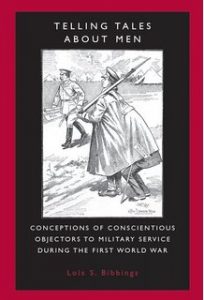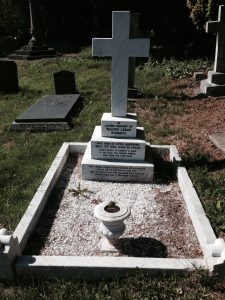By Prof Lois Bibbings, Professor of Law, Gender and History (University of Bristol Law School).*
 A hundred years ago general military conscription was introduced into Britain. The Military Service Acts of 1916 meant that men aged between 18 and 41 were deemed to have enlisted and decisions as to what happened to them were now in the hands of the state. However, in a controversial and seemingly contradictory move, the Act allowed men to be exempted from military service on the grounds that they had a conscientious objection to the undertaking of combatant service. These conscientious objectors (COs) deserve to be commemorated – and that is precisely what a series of events around the country are seeking to do.
A hundred years ago general military conscription was introduced into Britain. The Military Service Acts of 1916 meant that men aged between 18 and 41 were deemed to have enlisted and decisions as to what happened to them were now in the hands of the state. However, in a controversial and seemingly contradictory move, the Act allowed men to be exempted from military service on the grounds that they had a conscientious objection to the undertaking of combatant service. These conscientious objectors (COs) deserve to be commemorated – and that is precisely what a series of events around the country are seeking to do.
Although no exact figures exist, Cyril Pearce, the brains behind the marvellous Pearce Register of British World War One Conscientious Objectors, estimates that there were 20,000 COs – a very small number as compared to the around 5 million men who joined the military, most of whom were conscripts. Objectors were a diverse group. Their widely varying perspectives on the Act and their consciences led them to take very different courses. What is clear though is that they displayed remarkable conviction and courage, both as individuals and collectively.
The ranks of objectors included Quakers, Anarchists, Jews, Seventh Day Adventists, Socialists, Christadelphians, Methodists, Atheists, Plymouth Brethren, Agnostics, Anglicans, Socialist Christians, Bolsheviks, Buddhists, Tolstoyans, Spiritualists, Muggletonians, Jehovah Witnesses and Anglo-Israelites, as well as those with more ‘freelance’ beliefs. There were those who embraced pacifism, those who were quite happy to fight in a class war but would not bear arms against their fellow workers and those who refused to take part in any battle save the final conflict foretold in the Book of Revelation. There were men who would take no direction from the state, and those who only objected to killing with their own hands, so were willing to work in munitions production or to undertake a non-combatant role in the military.
These men sometimes braved social ostracism, with communities and families rejecting them. They were portrayed as having willfully adopted a pariah status by mainstream patriotic propaganda. In terms of gender, their masculinity was called into question and they were branded as cowards. Moreover, COs came to be viewed by some as a ‘suspect community’, now a widely accepted term in the context of responses to terrorism, meaning that they were perceived as dangerous – possibly they were plotting revolution or maybe they were working for the Kaiser.
COs suffered at the hands of the tribunals tasked with judging their consciences and deciding what, if any, exemption to grant (although there were also objectors whose consciences led them to refuse to apply for exemption). Indeed, certain of these bodies became notorious for the standard of (in)justice applicants could expect to face if they dared attempt to evade the military – with insults and a refusal to hear a case by no means uncommon. Where a tribunal did hear an application the outcome was often unsatisfactory for the objector involved. Many found that a decision to place them in a non-combatant role in the military failed to satisfy their consciences. Others rejected the offer of alternative service in the form of civilian work of national importance (in the factories or fields, for example) on the grounds that they could not accept any state direction or because such labour would free up another man for the military. Some found their case rejected out of hand with tribunal members refusing to implement the Military Service Act’s ‘conscience clause’.
 For those who rejected the tribunal’s decision or whose consciences were unrecognised, their path led into the military (although some evaded this temporarily or permanently by going underground or fleeing to Ireland or America). Once handed over, refusal to obey orders on conscience grounds could lead to attempts to break individuals to military discipline and then to court-martial and military detention. At Atwick Camp near Hull, John Gray was frogmarched, punched, stripped naked and, with a rope tied around his waist, he was pushed into a pond and dragged out again – this was repeated eight or nine times. At South Sea Camp, Cleethorpes, James Brightmore was kept in solitary confinement in a waterlogged pit measuring five or ten feet deep and three feet in diameter. Robert Forrester faced torture at the hands of the military too: in Wandsworth Detention Barracks, where he was dragged, kicked, choked, his head repeatedly banged on the concrete floor. Perhaps most famously the Army sent around 50 COs to France. There, as they were ‘under active service conditions’, they faced the prospect of execution should they continue to disobey orders. Some of their number were indeed sentenced to death but thankfully in all cases this was commuted to a term of incarceration. Despite all this suffering and threat to life, these men continued to follow their consciences.
For those who rejected the tribunal’s decision or whose consciences were unrecognised, their path led into the military (although some evaded this temporarily or permanently by going underground or fleeing to Ireland or America). Once handed over, refusal to obey orders on conscience grounds could lead to attempts to break individuals to military discipline and then to court-martial and military detention. At Atwick Camp near Hull, John Gray was frogmarched, punched, stripped naked and, with a rope tied around his waist, he was pushed into a pond and dragged out again – this was repeated eight or nine times. At South Sea Camp, Cleethorpes, James Brightmore was kept in solitary confinement in a waterlogged pit measuring five or ten feet deep and three feet in diameter. Robert Forrester faced torture at the hands of the military too: in Wandsworth Detention Barracks, where he was dragged, kicked, choked, his head repeatedly banged on the concrete floor. Perhaps most famously the Army sent around 50 COs to France. There, as they were ‘under active service conditions’, they faced the prospect of execution should they continue to disobey orders. Some of their number were indeed sentenced to death but thankfully in all cases this was commuted to a term of incarceration. Despite all this suffering and threat to life, these men continued to follow their consciences.
Unsurprisingly the military soon tired of their conchie ‘soldiers’ and the men were sent to serve their court-martial sentences in ordinary prisons rather than in military detention barracks. Consequently, in jails around the country a new type of outlaw who, in many cases, refused to kill was locked up amongst men convicted of homicide. There they faced the harsh regime experienced by ‘ordinary’ Third Division criminals sentenced to hard labour. The latter required them to be kept in solitary for the first twenty-eight days, then they would be allowed to work alongside others (generally this amounted to sewing mailbags for between six to ten hours each day). If well behaved, two months into their sentence they could communicate with family and suitable friends and receive visitors. At the same time the ‘silence rule’, meaning that prisoners were banned from communicating with each other, which had supposedly been replaced by a discretionary granting of permission to talk in some circumstances and for limited times, was seemingly revived for objectors. In addition, for those COs who refused to comply with the prison regime, disobedience could result in solitary confinement for long periods and a severely restricted punishment diet.
It soon became clear that imprisoned COs would still stand firm – when their sentences were served they would be released into military hands, again refuse to obey orders, once more be court-martialled and then sent back to prison to serve another term. In response the state offered an alternative – hard labour camps for imprisoned COs. Some accepted this option and found themselves collected in groups at camps around the country. Camp conditions varied. In some instances they could be hard, especially for the more physical vulnerable and for those who had already been tortured in the military or who had spent long periods on a punishment diet in prison. For instance, Walter Roberts, the first of an estimated 81 men to die as a result of their treatment, perished at Dyce Camp, Aberdeen in September 1916.
 The ‘Absolutists of peace’, however, refused all compromise. Rather than labour for the state they remained in the military→court-martial→prison loop. Some of their number protested against their treatment by hunger-striking, calling for recognition as political prisons. As a result, they, like the suffragettes before them, faced the torture of force feeding.
The ‘Absolutists of peace’, however, refused all compromise. Rather than labour for the state they remained in the military→court-martial→prison loop. Some of their number protested against their treatment by hunger-striking, calling for recognition as political prisons. As a result, they, like the suffragettes before them, faced the torture of force feeding.
Eventually objectors were released – from prison, from the military, from the Non-Combatant Corps and from work of national importance (the last re-entered civilian life in January 1920). But suffering could continue. Many temporarily lost their right to vote as a result of their wartime stance. Some experienced difficulties in reintegrating in society – and there were families permanently divided by their views on war and fighting. Obtaining employment could be difficult too.
But this is by no means the whole story. COs did not stand entirely alone, nor were they universally rejected and reviled. Various organisations supported them, most prominent of which was the No-Conscription Fellowship. Families and communities could stand by rather than reject their CO menfolk, seeing them as heroic and manly, living according to their deepest held beliefs, whether Socialist, Christian or Atheist – and, in some circumstances, showing great bravery in their suffering.
Perhaps most significantly, conscripts and volunteers as well as professional soldiers, were often the first to recognise the courage displayed by objectors – and there was some understanding of their stance, exposing doubts about the war from within the military. Additionally, after the war many objectors thrived – with a significant number, like Bristol CO Walter Ayles, entering Parliament. Indeed, all this serves as an important reminder that the country was by no means universally in favour of conscription – or of the war.
In the light of these stories, the conviction, faith and individual as well as collective strength of COs deserves to be commemorated. These men stood up for what they believed and that alone warrants recognition. With this in mind, I close with the words of a military man, Commander Wedgewood MP, speaking in the House of Commons in June 1917:
I think I am prouder of my country than I was before, because it has produced people who have sufficient conscientious scruples to enable them to face a long term of imprisonment rather than upset their consciences. It is something to be proud of even to produce martyrs of this sort as well as martyrs on the battlefield.
* Lois Bibbings’ book about WW1 COs, Telling Tales About Men: Conceptions of Conscientious Objectors to Military Service During the First World War, was published in 2009.
A series of Bristol events taking place in 2014-19 and organised by Remembering the Real WW1 includes a focus on conscientious objectors. The summer 2016 programme is now available at https://network23.org/realww1/ Lois Bibbings will be speaking about her work on COs on October 15th.
A version of the Pearce Register of British World War One Conscientious Objectors is available at https://search.livesofthefirstworldwar.org/search/world-records/conscientious-objectors-register-1914-1918.
For more information about Walter Ayles, see http://www.brh.org.uk/site/articles/walter-ayles/
